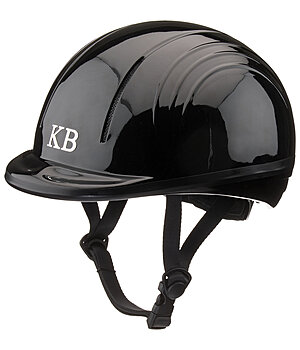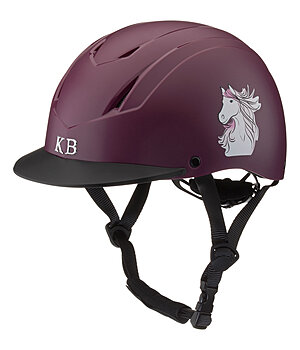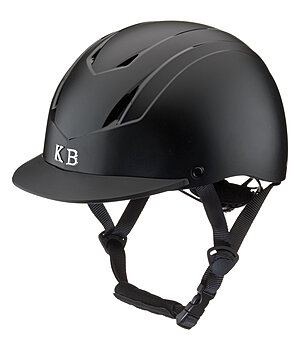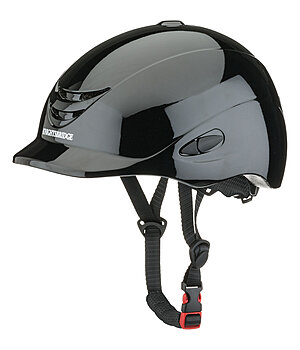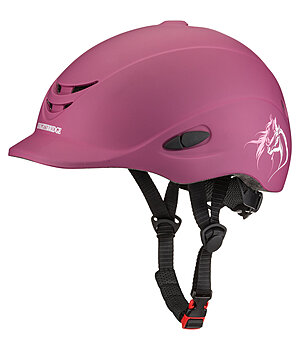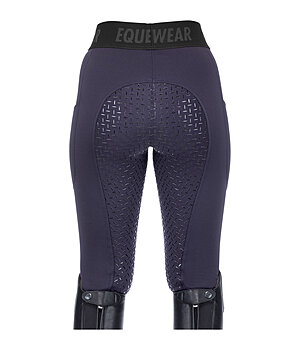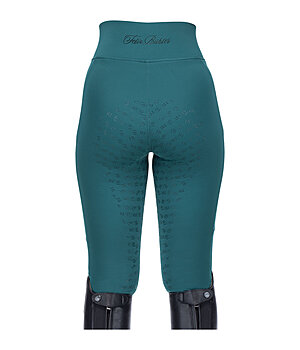Riding equipment for children – the checklist
The time has come – your child will soon be sitting in the saddle for the first time. Maybe your child has already done their first laps on the lead rein. Children often wear a cycle helmet and wellies when sitting on the back of a pony for the first time. You can find out why you should opt for special children’s riding clothing for riding lessons and which components are part of a complete riding outfit in our guide.


Why should your child wear special children’s riding clothing?
Many parents put off buying riding equipment for their child for the time being – all too often it happens that the desired hobby doesn’t fulfil their expectations after all and it only takes a few trial lessons.
To make your child’s introduction to riding as comfortable as possible, they should wear well-fitting children’s riding clothing that meets the requirements. On the one hand, your child should have a good grip in the stirrups and saddle, freedom of movement must be guaranteed by stretchy textiles and, first and foremost, the risk of (life-threatening) injuries can only be minimised with special equipment.
You should start thinking about buying children’s riding equipment after the first successful trial lessons at the latest.
6 myths you will encounter when buying children’s riding clothing
Unfortunately, there are still some myths circulating among parents and children about buying children’s riding clothing, which we would like to correct:
A cycle helmet and wellies will do just fine
A very clear no. There are different helmets for each type of sport, as the typical accident scenarios in the event of a fall from a horse, bicycle or inline skates are different in each case. Cycling helmets are primarily designed to safely cushion falls from the front, whereas riding hats focus more on protection against falls to the side or back of the head. The details and testing procedures of the helmets also differ significantly and are designed very specifically for the respective sports:

| Riding hat | Bicycle helmet |
| Designed for side falls | Designed for frontal falls |
| Very high protection also for the back of the head | Focus on protecting the forehead and front skull area, usually with a pronounced shield to prevent facial injuries |
| Ventilation holes are additionally protected with mesh to prevent snagging on branches etc. when hacking | Sometimes very pronounced ventilation holes without protective nets for maximum ventilation when cycling |
| Elaborate construction to cushion even hoof kicks with high impact force | Lightweight construction with a focus on aerodynamic shape |
| Current riding hat standard VG1 | Bicycle helmet standard DIN EN 1078 CE |
safe and stylish riding hats for your child
In addition to a children’s riding hat, the right footwear is also important for safety when riding. A small heel suitable for riding and a non-slip sole without a rough profile are a must in order to have a good grip in the stirrups and not slip. However, it doesn’t matter whether you choose jodhpur boots for children or children’s long riding boots.
The soles of commercially available rubber boots are usually smooth and slippery, so there is a risk of the child slipping through the stirrup with the wellie. They are also cut very wide so that the child could lose the boot while riding and the horse could be frightened by the falling boot.
affordable jodhpur boots and long riding boots for beginners

The more expensive the riding hat, the better it protects
All riding hats for children must fulfil the requirements of the current riding hat standard VG1 and are therefore put through their paces in an extensive test procedure. A cheaper children’s riding hat can therefore protect just as well as an expensive model. While inexpensive models usually have more basic features and a simple design, more expensive models are equipped with innovative ventilation holes, a particularly skin-friendly lining or an attractive design. In any case, inexpensive children’s riding hats do not skimp on safety.
Used children’s riding clothing is cheap and good
Buying children’s clothes can be expensive, especially if you have to change your child’s clothes every few months after a growth spurt. Many parents therefore like to shop at children’s flea markets or digital flea market platforms. Is this also a good solution for children’s riding clothing? Yes and no. Children’s breeches and tops are usually still in top condition and can be bought second-hand without hesitation. With safety equipment such as riding hats, back protectors and body protectors for children, a perfect fit is essential to provide reliable protection, so you really have to be lucky to find something suitable for your child when buying second-hand models. In addition – and this is especially true when buying second-hand children’s riding hats – it is impossible to tell whether the riding hat has already been involved in a fall, whether it may have fallen out of the child’s hand onto the ground several times (yes, even the smallest hairline cracks can occur here, which significantly reduce the protective function of the hat) and where the hat has been stored (hot temperatures, such as when the riding hat is stored in the car in summer temperatures, cannot be tolerated by the material).
Buy larger so that you can use it for longer
The same applies here: safety equipment only protects if it fits perfectly. Children’s riding hats, back protectors and body protectors must fit perfectly to ensure protection. Advice from trained specialists is strongly recommended here.
A good fit is also important for children’s riding boots, riding gloves and breeches to ensure they are comfortable to wear. This can help prevent sores and blisters on hands and feet.
Children’s riding clothing is expensive
Riding clothing for children doesn’t have to be expensive. Whether it’s a children’s riding hat, breeches or riding boots for children – there are always affordable alternatives and basic models that are available at affordable prices without having to compromise on quality and safety. What’s more, the child doesn’t have to be covered from head to toe in riding clothing. While riding hats, riding boots and breeches/jodhpurs as well as riding gloves are mandatory for children due to their safety-relevant properties, it only plays a secondary role in children’s tops whether the child is wearing a special functional riding shirt or a conventional shirt from the fashion shop. Although children’s riding tops offer many advantages, e.g. particularly breathable material, nothing stands in the way of a riding lesson in a cotton shirt. Just make sure that shirts and jackets are not too long and loose-fitting so that the child doesn’t get caught on the cantle.
Children’s riding clothing is stiff, uncomfortable and looks uncool
Many parents who took riding lessons themselves as children remember the classic rigid velvet riding hats with chin guards that everyone wore. A lack of ventilation, a poor standard fit and a pinching chin guard made of hard plastic material (which is now banned for riding hats and poses a safety risk) are just as much a part of the memories as the stiff corduroy breeches that were worn in summer and winter, with a rigid waistband that cut into the waist and a Velcro fastening on the leg that caused chafing around the ankles.
If you look at today’s children’s riding fashion, nothing reminds you of the riding clothing that was available in the early nineties. Highly functional textiles that ensure maximum breathability, comfortable cuts for maximum freedom of movement, practical details and fashionable designs show that the days when children’s riding clothing was uncomfortable and boring are long gone.
Particularly noteworthy here are the children’s riding tights, which offer the optimum conditions for maximum comfort in the saddle with their flexible waistband and stretchy material. Children’s competition fashion, which was the epitome of uncomfortable with its heavy competition jackets and competition shirts with stiff collars, has also adapted to the needs of children with breathable and stretchy materials, without compromising on elegant design.

SHOP COMFORTABLE RIDING TIGHTS FOR YOUR CHILD
The checklist – What riding equipment does my child need?
We now know what to look out for when buying children’s riding clothing. Before the first riding lesson, you and your child may be looking for suitable children’s riding clothing online. To make sure you don’t forget anything, we’ve put together a checklist for you of what you need to think about and what you should look out for when buying:
MUST HAVES
| Equipment | What to look out for? |
| Children’s riding hat | – Does the riding hat comply with the current riding hat standard? – The fit is not too loose and not too tight (must not slip when moving, even when the buckle is open) – The 3-point harness encloses the ear – The hat brim sits approx. 2 finger widths above the eyebrows – Pay attention to wearing comfort (should not pinch, ventilation systems, soft and skin-friendly lining, easy handling of fasteners) Adjustable riding hats Choose the smallest possible size to minimise the space between the shell and fastening. |
| Children’s breeches | – do not cut in, even when seated – The knee area is crease-free – Seams and zip do not stretch – Breathable material – For beginners, full synthetic leather seats are recommended to ensure a good hold in the saddle and to prevent the breeches from sticking to the saddle as with silicone seats |
| Jodhpur boots or long riding boots for children | – heels suitable for riding and non-slip, flexible soles without a rough profile – Choose the right shoe size (always allow 12 to 15mm clearance for children) – Does the shoe pinch when walking? – Try them on in different positions – Waterproof and easy-care material such as rubber is ideal for children, so their feet don’t get wet even when jumping in puddles For long riding boots: – Tight fit at the calf, but still enough room to put a flat hand into the side of the shaft. – Pay attention to the height of the shaft: should not end directly at the back of the knee and cut in, even when kneeling – For leather riding boots: note that the material can settle by 0.5 to 1cm For jodhpur boots: – Do not cut into the ankle when walking – Matching half chaps to increase grip on the saddle (tight fit without cutting in, no creases, should end approx. 2 finger widths below the hollow of the knee) |
| Riding gloves for children | – When trying them on, the child should move their hand, clench it into a fist, fold their hands into each other – Riding gloves should be easy to slip on and the hook and loop fastener should be able to be closed within the intended area – Should lie comfortably on the hand and allow all movements without being tight – No slipping, no creasing, well-fitting cuff – There should be enough room for the fingers, but not too much space between the glove and fingers so that sensitivity is not lost – Should be breathable, especially for children, and warm in winter – Sollte insbesondere für Kinder atmungsaktiv und im Winter wärmend sein |
Body and back protectors for children
Many parents want maximum safety for their riding child and rely on safety equipment such as body protectors or back protectors. However, body protectors may restrict freedom of movement under certain circumstances and interfere with learning to sit in a balanced position. As soon as your child goes hacking or jumps for the first time, you can think about purchasing a body or back protector. You can find out what you should definitely look out for in our guide to body and back protectors.
NICE TO HAVES
| Equipment | What to look out for? |
| Children’s riding shirts | – Comfortable cut – Breathable material – Not too long and not too wide – Adapted to the respective weather conditions |
| Children’s riding jacket | – Breathable – Ideally waterproof or at least water-repellent – Fit not too tight, but not too wide either – High collar to protect against unpleasant wind and make wearing a scarf unnecessary (safety risk of getting caught) – For riding jackets: not cut too long to avoid catching on the back pommel – For riding coats: Equipped with riding slits for a perfect fit in the saddle |
| Children’s riding socks | – Well-fitting band that does not cut in but is not too loose – Ideal boot height to make it easier to get on – Skin-friendly material, e.g. with high cotton content – Warming materials such as merino wool in winter |
Children’s riding gilets for the transitional period
Temperatures are unpredictable in spring and autumn. It can be anything from mild T-shirt weather to an uncomfortable storm. A riding gilet is the classic garment to be prepared for any weather. It also gives your child the best freedom of movement – even in the saddle.

For many children, taking part in a horse show is a dream come true – in the appropriate outfit, of course. In the next chapter of our guide to children’s horse shows, we will provide you with all the important information you need for your child’s show participation and you will also receive a competition checklist to download free of charge so that you are guaranteed not to forget anything.



